Small boats, closely packed, full with colourful fruits, rice or fish in paltering marketers -
hustling and bustling on the Klongs (canals) of Bangkok when Thai merchants arrive with their boats on the floating markets.
"Which Klongs are best for your boats?" Players take turns and bring their boats to the floating markets. They tow them into the best position as this is important for the success or failure of market day. The only Klongs which are profitable are those with enough boats huddled around, the rest go away empty-handed.
But not only are the market days important for the merchants' success, the final scoring of their stock will be important as well. The player who focuses only on some goods will come off especially well, as the collection of several different goods will not always give you a larger final score.
Components
1 gameboard
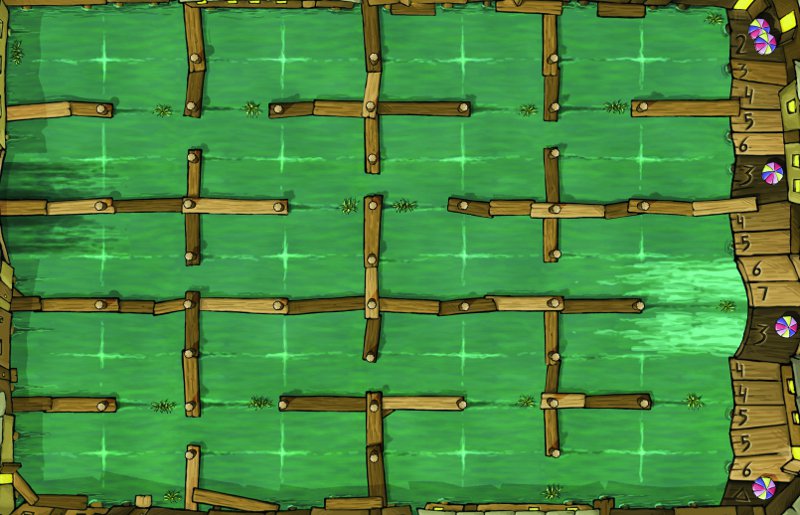
68 wooden merchants in 4 colours (red, yellow, green and blue)
72 boats, for example 



8 movement cards, 2 for each colour 
1 Luk Phat counter 
1 Master of the Market counter 
2 special counters 
Set-up
Place the board in the middle of the table.
Shuffle the boat cards face down on the table and place them in a stack next to the board. Each player draws 4 cards from the stack, keeping them secret from the other players.
Each player selects a colour and gets merchants and the two movement cards of this colour. He places both in front of him on the table. Each player places one merchant on the space 0 of the scoring track around the gameboard.
The number of merchants depends on the number of players. With 2 players: each player gets 17 merchants, with 3 players: 12 merchants, with 4 players: 9 merchants. Extra merchants are put away.
Place the Luk Phat counter on the lowermost space of the Luk Phat scale.
Place the Master of the Market counter next to the board.
Course of the game
The youngest player begins. Play then follows clockwise.
On a player's turn he places one of his boat cards on a free water space on the gameboard according to the rules of movement (see rules of movement).
Afterwards, the player draws a new boat from the stack of boat cards to fill their hand back to 4 cards.
Each time a boat showing the Luk Phat symbol  is placed on the board, the Luk Phat counter moves one step on the track. The player gets the points displayed on the space and moves forward his scoring marker accordingly on the scoring track.
is placed on the board, the Luk Phat counter moves one step on the track. The player gets the points displayed on the space and moves forward his scoring marker accordingly on the scoring track.
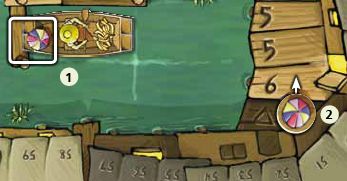 |
Example: Mary places a boat displaying the Luk Phat symbol (1).
The Luk Phat counter moves from the starting area to the next space with the number 6 (2).
Mary gets 6 points and moves her scoring marker 6 steps on the scoring track. |
If the Luk Phat counter moves to a market day space (marked with  )
the player gets points and a market day scoring event will take place. The scoring for Little Market Day and Big Market Day are similar (for differences see Big Market Day).
After scoring a Little Market Day the game continues.
After scoring the Big Market Day, only the final scoring of the stock will take place (see scoring stock).
The player whose merchant is at the front of the scoring track after the final scoring is the winner of the game!
)
the player gets points and a market day scoring event will take place. The scoring for Little Market Day and Big Market Day are similar (for differences see Big Market Day).
After scoring a Little Market Day the game continues.
After scoring the Big Market Day, only the final scoring of the stock will take place (see scoring stock).
The player whose merchant is at the front of the scoring track after the final scoring is the winner of the game!
The boats
Usually, the boats consists of 3 different elements: goods, merchant and value.
Boats showing a merchant are owned by a neutral merchant. Players cannot take possession of these boats (see image).
Boats without merchants, showing an empty space, aren't yet owned.
The player who places such a boat can take possession of it by placing their own merchant on it.
If a player places a boat with an empty merchant space and all of his merchants have been used on other boats, he has 2 options:
he can decline to take possession of the boat or he can remove a merchant from another boat and places it on the new boat.
Each boat (except boats having special features like a thief, inspector or cookshop) carries goods in the front.
There are 7 different goods available (shrimp, flowers, avocados, pineapples, eggplants, fish and bananas)
which will be important for the final scoring of the player's stock at the end of the game.
Some boats carry baskets (0, 1, 2 or 3 baskets). They show the value of the boat and are important for the scorings.

Some boats also display the Luk Phat symbol.
If one of those boats is placed on the gameboard, the Luk Phat counter moves forward 1 step on the Luk Phat track.
The reached space indicates the number of points the player gains. Some spaces also trigger a market day.
There are also some boats in the game which have special features such as a thief (1), inspector (2) or cookshop (3) (each feature is available 3 times in the boat cards).
See Boats with special features. |
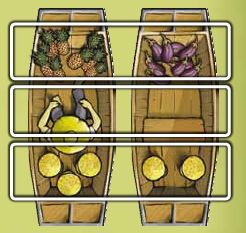 Boats Boats

Goods
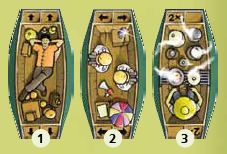
Special boats |
Rules of movement
In the first turn each player has to place the boat on one of the entry spaces. When 2 players are playing they only use the light water spaces, with 3 or 4 players they also use the dark fields on the other side of the gameboard.
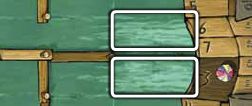
After the first turn, each subsequent boat has to be placed next to another boat, either adjacent (shoulder to shoulder) or diagonally (corner to corner). The jetties do not prevent boat placement.
The jetties separate the gameboard in market hoods. Each of them consists of 4 water spaces (1). In the market hoods, only 3 water spaces can be occupied by boats, one has to remain empty. If 3 water spaces in a market hood are taken by boats, the remaining space has to stay vacant (2).
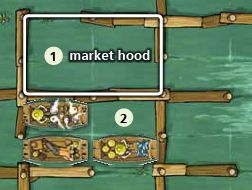
Players are not allowed to place a thief into an area of influence of an inspector (see Boats with special features).
In addition to placing a boat each player may move one of his own boats using his moving card. This option is available two times during the game, but only once during a player's turn (before or after placing a new boat). The player has to discard his moving card and may move one of his boats to a bordering space (adjacent or diagonally). The jetties do not prevent this movement. Displaced boats must not be adjacent to other boats.
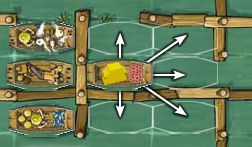
A player's turn ends by taking a new boat card from the stack to replenish their hand to four cards. If there are no cards left to draw, boat cards will be played in turn until the Big Market Day takes place.
Market Days (scoring)
When the Luk Phat marker moves either to Little Market Day or Big Market Day, scoring will take place immediately.

Little Market Day: The player who initiated the Little Market Day is the first to place the Master of the Market and score.
Players' scoring goes in clockwise order until each player has scored at most 2 times.
If a player is not able or chooses not to score, he may decline. Other players can still score again if a player declines to score (up to 2 times).
Scoring: The player takes the Master of the Market and places him on a landing point.
The landings are situated on the jetty intersections and always connect 4 water spaces.
All 4 water spaces must be occupied by boats and at least one of the boats must be owned by the player who is initiating the scoring.

Evaluation: The number of baskets on the boats situated around the landing are added together (the baskets on the thief's boat do not count). This number is multiplied by the number of merchants, in each player's colour. This means each player who owns a boat on one of the 4 spaces of the scoring quartet gains points, not only the player who scores!
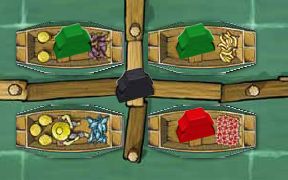
Example: John (colour green) is initiating scoring on one landing.
All in all, there are 2 + 3 + 0 + 0 = 5 baskets.
John owns 2 boats, therefore he will get 5 x 2 = 10 points.
Eve (colour red) owns one boat of the quartet as well, so she will get 5 x 1 = 5 points.
After scoring, the player who initiated scoring, removes a boat of his own out of the scoring quartet. The merchant on this boat will go back into the player's pool and can be used again. The removed boat is placed in the player's stock in front of him. At the end of the game the player will score for his stock (see Scoring of stock).
Note: When removing a boat, water spaces can become empty which have been occupied before.
Note: By applying the rules of movement (boats can be placed only adjacent or diagonally), connected chains are generated. When removing a boat, those chains will be disconnected. This has no effect on the rules of movement.
After 2 scoring rounds, the Little Market Day is completed. The players go on placing boats as before, starting with the player on the left side of the player who initiated the Little Market Day.
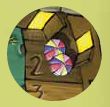
Big Market Day: Both market days are similar with the following differences:
The Little Market Day starts with the player who initiated the scoring. Now the player whose merchant is the last on the scoring track, starts. In case of a tie, the player who has less merchants on the gameboard starts. In case it is still tied, the tied player earliest in clockwise turn order (starting at the player who caused the scoring) begins.
The Little Market Day has at most 2 scorings. The scorings of the Big Market Day will proceed until no more scoring is possible or no player is willing to score again.
-
During the Little Market Day, players are only allowed to remove their own boats, however, now they may take a neutral boat. Foreign boats are still forbidden.
Boats with special features
As already mentioned, there are 3 types of boats with special features: thief, inspector and cookshop.
Thief: When placing a thief-boat on the board, the player can take a boat of his choice that is horizontally aligned with where the thief's boat has been placed. The arrows on the boat show the line. He can also remove a boat from another player. He can choose any boat except an inspector's boat which cannot be taken out of the game. The merchant on the removed boat goes back to its player and can be used again. Afterwards, the player has two choices: to put the boat into his stock and to draw a new boat from the stack, or to put it in his hand without drawing a new boat from the stack.
Inspector: The inspector protects all boats that are vertically aligned to it against the thief. The arrows on the boat show exactly the line where the boats are protected. Players cannot place a thief on spaces of the protected line. If there already is a thief on a space in the protected line, the player who placed the inspector removes the thief. He either can discard the thief and draw a new boat from the stack, or he can take the card into his hand without drawing a new card.
Special case: If there are 2 thieves in a protected line, the player who has placed the inspector, removes both thieves. However, he is only permitted to take one of the thieves into his hand, the second one will be removed and discarded. He also may discard both thieves and draw a new card from the stack.
Cookshop: This boat is important for scoring. Points will be doubled if there is a cookshop in a scoring quartet.
Scoring of the stock (final scoring)
The scoring of stock takes place after the scoring of the Big Market Day. Thieves, inspectors and cookshops have no goods on board, thus the owners will not gain points for them. Each type of product will be scored as follows: For the first product card of one type the player gets one point, for the second card of the same type he gets 2 points, for the third 3 points and so on.
Example: Sarah owns a boat carrying bananas (1 point).
3 boats having fish (1 + 2 + 3 = 6 points) and 7 boats with flowers (1 + 2 + 3 + 4 + 5 + 6 + 7 = 28 points) in her stock.
She moves her merchant on the scoring track 1 + 6 + 28 = 35 steps.
Game variation
Skilled players can change the rules as follows to reduce luck and to bring more strategy into the game: The boat cards will be divided into 2 stacks.
Stack 1 have all boats with merchants (neutral boats) and with special features (thief, inspector and cookshop),
stack 2 have all boats without merchants. Both stacks will be shuffled and placed face down beside the gameboard.
They should be labelled with the special counters so players can tell the difference.
Before the game starts each player takes 3 boats from stack 2 without merchants and one boat from the stack 1 with merchants and boats with special features.
From then on players decide from which stack they will draw a boat to complete their hands.